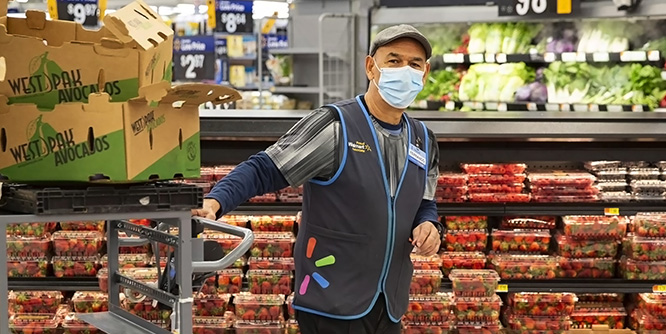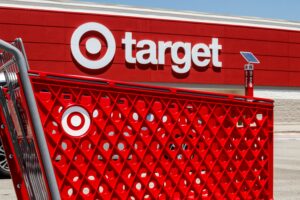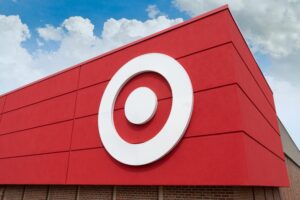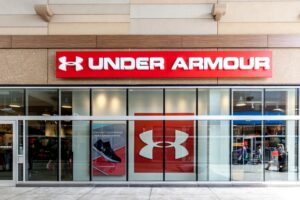
Photo: Walmart
May 18, 2022
Walmart and Target report higher sales and lower margins
Walmart and Target posted their first quarter results this week and the rivals had similar stories to tell of sales going up and profit margins falling down.
Walmart reported that same-store sales for its U.S. business were up three percent year-over-year in the first quarter and plus nine percent over 2020. The company’s Sam’s Club unit posted comps that were up 10.2 percent and 17.4 percent on a one- and two-year basis.
Both Walmart U.S. and Sam’s saw declines in gross profits due to rising supply chain costs and product mix issues where seasonal merchandise failed to sell due to inclement weather across much of the U.S. heading into spring. Walmart’s gross profit fell 87 basis points during the quarter.
Doug McMillon, president and CEO, Walmart, said the company’s “bottom line results were unexpected and reflect the unusual environment. U.S. inflation levels, particularly in food and fuel, created more pressure on margin mix and operating costs than we expected. We’re adjusting and will balance the needs of our customers for value with the need to deliver profit growth for our future.”
Walmart’s CEO said yesterday on the company’s earnings call with analysts that general merchandise made up a lower percentage of sales in the first quarter, and that created an “unfavorable gross margin mix.”
Mr. McMillon said that the company incurred “higher costs for containers and storage, and we’ve taken and are taking steps to contain those cost pressures to the first half of this year.”
Fuel costs, a growing challenge since the start of Russia’s invasion of Ukraine, was cited as a factor in Walmart’s lower than expected earnings.
Target today reported that it grew comp sales 3.3 percent during the first quarter on top of a 22.9 percent gain during the same period last year. The chain’s digital comps were up 3.2 percent following a 50.2 percent jump in the first-quarter of 2021.
The retailer’s higher sales, however, could not mask the bottom line issues it must confront.
“Throughout the quarter, we faced unexpectedly high costs, driven by a number of factors, resulting in profitability that came in well below our expectations, and well below where we expect to operate over time,” said CEO Brian Cornell.
Target pointed to actions it took to reduce excess inventory and higher freight and supply chain costs as major factors affecting its profit margins.
Discussion Questions
DISCUSSION QUESTIONS: What do you make of the first quarter results posted by Walmart and Target? What advantages and disadvantages do you see either retailer having versus the other when it comes to maintaining operating margins?
Poll
BrainTrust
Lisa Goller
B2B Content Strategist
Brandon Rael
Strategy & Operations Transformation Leader
Mohamed Amer, PhD
CEO & Strategic Board Advisor, Strategy Doctor
Recent Discussions







As these earnings reports make clear, even the largest retailers aren’t immune to profit challenges. Supply-chain costs and the impact of inflation on discretionary purchases are clearly impacting results. But while their results are disappointing relative to expectations, both retailers are still very well positioned to manage these challenges, and I have no doubt that their results will improve — assuming inflation starts to decline. But until then, results will remain choppy and somewhat unpredictable.
Do the “higher sales” account for inflated prices? If they don’t, their sales were actually lower, not higher. This was to be expected. These two retailers don’t rush to raise their prices much higher because they try to understand the demographic they serve, and if the price hikes were enough to match the increase in the retailers’ cost, that demographic would just cut back on the price points and quantities they typically buy.
This is not a surprise to anyone who carefully watches the consumer economy. There has been a sales mix shift to grocery (thanks to higher inflation and lower disposable incomes) which is lower margin. At the same time, costs – especially for freight – are up sharply. However both retailers have grown over pre-pandemic levels and are stronger and better businesses as a result. This is a reversion to more normalized trading, not some cataclysmic event, although a new era will necessitate new trading and operating strategies. And Walmart and Target are both fortunate as they have grocery to drive footfall and offset spending moderation in other categories.
The challenges Walmart and Target are experiencing can’t be eradicated in a single quarter. Excess inventory and markdowns threaten to become the unwelcome gifts that keep on giving into the back-to-school season. On one hand, Walmart is well positioned to weather inflation when compared to its competitors – it has the buying clout and business model diversity to adjust. Yet Walmart also operates under a low-cost premise and relies heavily on price-sensitive categories like grocery to drive traffic. Any uptick in prices can impel shoppers to migrate to seek out alternatives such as ALDI or dollar stores. When that happens, both Walmart and Target lose the ability to trigger sales in higher-margin general merchandise. Target may be better positioned to sell higher-margin apparel and home goods while shoppers are in its stores, yet its hard-won improvements in grocery are what drives the footfall.
We shouldn’t expect the same news next quarter, as they will need to raise prices to keep the market wolves at bay.
The sales results are good considering the comps from Q1 in 2021, and the margins are not surprising. Along with higher supply chain costs, consumers are shifting from discretionary goods to essentials given the higher cost of groceries and gas — and that kind of margin mix is never good for the bottom line. Stores like Target and Walmart are strong enough to weather the inflation storm, and to avoid passing too many price increases to their shoppers; they will win market share over the long run.
I see higher sales generated by fewer customers buying more goods. And the “usual suspects” on cost drivers listed in the article. I believe Walmart has the advantage here as their lower price points make them a more attractive alternative for wealthy customers shopping down-market and the rest of us who are stretching our budgets. Retailers need to recalibrate their pricing to match the market realities generated by the Ukrainian conflict, and forecast said recalibration to the Street.
On the other hand, Target has been hitting on all cylinders lately, as far as having big decisions pay off. So I can understand why some would put money on Target to outperform Walmart on building back their margins. Target’s demographics should be somewhat less price sensitive, too. That would allow them to inch up on prices and capture more margin without ringing alarm bells. Okay, I’ll admit this will be a close race. I’ll go with very little on the over!
These results prove even retail giants struggle to navigate current market risks.
Walmart’s strength lies in its grocery and low-cost leadership as value shopping surges. Target’s beloved stores, people and solid partnerships give it an edge.
Both retailers must contend with high omnichannel costs and aggressive competition.
In order for these EDLP retailers to maintain their share and competitiveness with pricing, margin has to be sacrificed. It’s the game of margin dollars versus margin percent. Walmart and Target are both still servicing their base while also expanding their assortments towards more premium goods/brands to win that customer over as well for a balanced mix.
By far the biggest news from Target’s earnings this morning are that supply chain issues are expected to persist into 2023.
Target’s operating margins even at 6 percent predicted this year would STILL be industry-leading, compared to its normal 8 percent industry-leading margins.
Target’s shift to store-based fulfillment in the past five years gives it incredible operating leverage moving forward as compared to its peers.
Not to mention the best same-day services in the industry.
Higher sales and lower margins seem to be the norm in this cycle and it’s not unexpected. Supply chain issues (specifically freight) still continue to be a problem across the retail sector. Vendor partners are forecasting inflation to continue into 2023, so those aforementioned issues will continue as well and retailers will be make adjustments accordingly to compensate for it.
Walmart and Target are well-positioned to ride out the inflationary period and supply chain disruptions. Both companies had solid earning reports and reported strong comp and revenue growth. However from an EBITDA perspective, both Walmart and Amazon have been impacted by the rising operational costs, including fuel, cargo, supply chain disruptions, and the overall impact of the record inflationary period we are experiencing.
Both firms are resilient and adaptive to ride out this inflationary storm period. It will take collective creativity to determine ways to reduce the costs to serve. Strategically, this may include increased penetration of private label assortments, extending their micro-fulfillment capabilities, and extending more promotional offerings to their most loyal companies. They will find a way to course-correct to maintain their margins and profitability levels.
Walmart and Target are built for this and ready for this moment from an operational, organizational, technological, and innovation perspective.
There are too many fluctuations in the variables to make strategic decisions based on one or two quarters. Both retailers, like the other behemoth Amazon, are all in this for the long run. For Walmart the fiscal year projections show a 4 percent increase in sales and over the next two quarters, the inventory levels should come back into balance. Walmart has the advantage on operating expenses whereas Target has the advantage on gross margins. Both companies are chasing the global advertising business as a revenue stream to offset other expenses.
Given the press that certain companies may be padding their margin by raising prices unnecessarily, I think this is good news for all of us as consumers that two leading retailers don’t seem to be doing this.
These results are a warning to those that still view the consumer as in good shape. Demand for discretionary goods is flagging, and inflation pressures create difficult consumer spending decisions against macro headwinds with the Fed rate hikes and the GDP trending lower. To maintain margins, retailers will need to raise prices when consumers are under pressure. We are in a hostile environment, and earning results for the next quarter will not be better.
This happens when retailers don’t adjust quickly to unavoidable COGS increases (as suppliers HAVE to take price increases), plus a strong reluctance to increase shelf prices, combined with shoppers shifting from higher margin general merch to necessary food purchases. Perfect storm of margin reduction.
With inflation as it is, this is not a surprising set of results. Turnover will be higher as inflation will account for much of the 3 percent sales increase and the increased operating costs from fuel, supply chain cost increases will erode profit margins. The product mix just makes the situation worse. The forecast is that the inflation period is likely to be months not years so we may just have to ride this out. What consumers need now is help from retailers in keeping prices in check, not pushing up prices and thus inflation higher still by increasing prices to cover margin erosion. It is at times like this that the most efficient retailers will prosper. Those that have not invested in up-to-date technology will be hit harder and find this to be a very tough period.
So much for those price gouging comments from politicians.
Both Target and Walmart will remain true to their brand promise during this period, and neither will be immune from the continued margin hits in coming months.
Target may have a modest edge on margins because they are slightly more brand centric, having a more layered product/merchandising strategy.
While Walmart should remain as the low price leader, helping shoppers easily find the savings on products they badly need right now, even as it pinches margin.
Given the noted economic environmental variables, these companies should not have been surprised the posted results. The critical question is do the supply side challenges continue beyond the short term and become the new abnormal? Walmart’s food investments should provide some advantages over Target. However, Target’s investments in fresh and grocery products have narrowed the gap between it and Walmart. Consumers’ expectations regarding inflation may give each retailer some price wiggle room.
Retailers’ input costs have surely grown due to inflation. In this case, retailers can either protect their profit margins by passing on the increased cost to their customers, or they can keep their customer base by absorbing the increased cost as long as it does not diminish their profitability. Walmart and Target chose the latter option, which I believe was a deliberate move. Given that such high inflation doesn’t persist forever, they will be able to improve profit margins in upcoming quarters. However, reacquiring customers is extremely difficult and often costly.